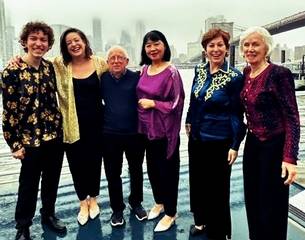|
Back
Lustrous Strings from East to West New York
BargeMusic
12/03/2023 -
Zhou Long: Song of the Ch’in
Dorothy Rudd Moore: Modes
Allen Shawn: Quintet (World premiere)
Cassatt Quartet: Muneko Otani, Jennifer Leshnower (Violins), Nicholas Perkins (Viola), Gwen Krosnick (Cello); Doris Stevenson (Piano)

A. Shawn with Cassatt Quartet, D.Stevenson (right)
(© Gail Wein/Classical Communications)
“Though the moon doesn’t understand wine,/I raise my glass, I sing, and moon rocks back and forth;/I dance, and shadows tumble into pieces./ Drunk,/we scatter away into our own directions:/intimates forever, we’ll wander carefree/and meet again in Star River distances.”
Li Po (Tang Dynasty).
Listening to the Cassatt Quartet, in the last of their three concerts this week, one felt a special joy. The instruments are lustrous, both solos and ensembles exuded a rare warmth. The last time I heard them, tonight’s pianist Doris Stevenson had joined them for the Dvorák Quintet–and that was reflected in the last notes of the evening.
Before Allen Shawn’s work, though, the Cassatt Quartet showed their unerring timing with each other in Zhou Long’s Song of the Ch’in. Having lived around China for many years, I never ever warmed up to the music itself. Arithmetically and technically it was fine, but it lacked the danceability of Indonesian and Thai or the religiosity of Japanese court music.
Zhou Long not only understands the sounds of the qin, not only can he duplicate it with four string players–but he gave a Western-style spirit to this music.
Specifically, his music is on that razor-thin cusp of East and West. For the latter, he separated the original seven strings to the total of 28 Cassatt Quartet strings. Then, from the very first plucking cello, he offered all the colors and hues of the qin itself. Not only plucking and vibrating, not only microtonal glissandi slurring, but mélange of all these colors at once.
Yes, it was a replica, but the sounds and hues were fair mirrors, and any Chinese musician would recognize–and probably applaud–the result.
Zhou Long, though augmented; this with some utterly enchanting melodies, mainly played in thirds by Muneko Otani and Jennifer Leshnower. They could have been Chinese or Rosenkavalier‑style duet. But amidst the Chinese sounds, they seemed normal and inevitable.
Dorothy Rudd Moore, who died two years ago, studied (as did Allen Shawn) with Nadia Boulanger. Her Modes, the centerpiece of the concert, was three movements of well‑crafted music. Dense at times, with a gentle Adagio and–best of all–a finale resembling an awkward hoe‑down. That was fun, and the Cassatt Quartet gave Modes their all. Yet the work seemed more an exercise in advanced composition than an original recital piece.
The world premiere was by Allen Shawn, whose diversity embraces a variety of piano music (the great Ursula Oppens premiered his Piano Concerto), concert, theater and film music (including My Dinner with Andre, starring brother Wallace, who was in attendance) and a number of excellent books.
I was reminded of his Arnold Schoenberg’s Journey from the very first three movements of his Quintet.
Schoenberg of course warned listeners about trying to “trace” his twelve‑note tone rows, and simply to listen. That is inevitably arduous. But Mr. Shawn simplified the Quintet by giving us a five‑note tone row. The first five notes roaming throughout the entire work.
More than simply repetitions, the Cassatt Quartet and Ms. Stevenson offered an infinite aggregation of permutations. Not the usual upside‑down and retrograde, but the notes changing from one string instrument to the other, separating that downward pentad into cells and quanta and diverse ensemble.

Z. Long/D. R. Moore
That was the tool. But simply recognizing it one had fun in another sense. For the opening slow-fast-slow movement and the “introspective” center movement, piano and strings played with a tension formed by contrasting emotion.
The Cassatt Quartet might be gently playing, while Ms. Stevenson was stepping up the rhythms of an entirely different part. Or she would be playing static chords, as the Quartet was dancing along with the major motive. It never became an aggravation or antagonism. Instead, the consorts enjoyed what is prosaically called “a debate among friends.”
Mr. Shawn’s finale was a ferocious change. All I could think was that if Antonín Dvorák was writing his Czech dumka finales around 2023 in Bennington College (where Mr. Shawn teaches), it would sound like this. I suppose those motivic five notes were hidden away, but one was more involved in the bumptious rhythms the surprising syncopations, the expressions of dance, rainbow colors, and joy, real joy.
Harry Rolnick
|